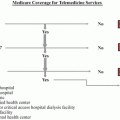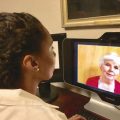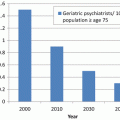CY 2016 Medicare Telehealth Services
Healthcare Common Procedure Coding System (HCPCS)/CPT code
Telehealth consultations, emergency department, or initial inpatient
HCPCS codes G0425–G0427
Follow-up inpatient telehealth consultations furnished to beneficiaries in hospitals or SNFs
HCPCS codes G0406–G0408
Office or other outpatient visits
CPT codes 99201–99215
Subsequent hospital care services, with the limitation of one telehealth visit every 3 days
CPT codes 99231–99233
Subsequent nursing facility care services, with the limitation of one telehealth visit every 30 days
CPT codes 99307–99310
Individual and group kidney disease education services
HCPCS codes G0420 and G0421
Individual and group diabetes self-management training services, with a minimum of 1 h of in-person instruction to be furnished in the initial year training period to ensure effective injection training
HCPCS codes G0108 and G0109
Individual and group health and behavior assessment and intervention
CPT codes 96150–96154
Individual psychotherapy
CPT codes 90832–90834 and 90836–90838
Telehealth pharmacologic management
HCPCS code G0459
Psychiatric diagnostic interview examination
CPT codes 90791 and 90792
End-Stage Renal Disease (ESRD) -related services included in the monthly capitation payment
CPT codes 90951, 90952, 90954, 90955, 90957, 90958, 90960, and 90961
End-Stage Renal Disease (ESRD)-related services for home dialysis per full month, for patients younger than 2 years of age to include monitoring for the adequacy of nutrition, assessment of growth and development, and counseling of parents (effective for services furnished on and after January 1, 2016)
CPT code 90963
End-Stage Renal Disease (ESRD)-related services for home dialysis per full month, for patients 2–11 years of age to include monitoring for the adequacy of nutrition, assessment of growth and development, and counseling of parents (effective for services furnished on and after January 1, 2016)
CPT code 90964
End-Stage Renal Disease (ESRD)-related services for home dialysis per full month, for patients 12–19 years of age to include monitoring for the adequacy of nutrition, assessment of growth and development, and counseling of parents (effective for services furnished on and after January 1, 2016)
CPT code 90965
End-Stage Renal Disease (ESRD)-related services for home dialysis per full month, for patients 20 years of age and older (effective for services furnished on and after January 1, 2016)
CPT code 90966
Individual and group medical nutrition therapy
HCPCS code G0270 and CPT codes 97802–97804
Neurobehavioral status examination
CPT code 96116
Smoking cessation services
HCPCS codes G0436 and G0437 and CPT codes 99406 and 99407
Alcohol and/or substance (other than tobacco) abuse structured assessment and intervention services
HCPCS codes G0396 and G0397
Annual alcohol misuse screening, 15 min
HCPCS code G0442
Brief face-to-face behavioral counseling for alcohol misuse, 15 min
HCPCS code G0443
Annual depression screening, 15 min
HCPCS code G0444
High-intensity behavioral counseling to prevent sexually transmitted infection; face-to-face, individual, includes: education, skills training, and guidance on how to change sexual behavior; performed semi-annually, 30 min
HCPCS code G0445
Annual, face-to-face intensive behavioral therapy for cardiovascular disease, individual, 15 min
HCPCS code G0446
Face-to-face behavioral counseling for obesity, 15 min
HCPCS code G0447
Transitional care management services with moderate medical decision complexity (face-to-face visit within 14 days of discharge)
CPT code 99495
Transitional care management services with high medical decision complexity (face-to-face visit within 7 days of discharge)
CPT code 99496
Psychoanalysis
CPT codes 90845
Family psychotherapy (without the patient present)
CPT code 90846
Family psychotherapy (conjoint psychotherapy) (with patient present)
CPT code 90847
Prolonged service in the office or other outpatient setting requiring direct patient contact beyond the usual service; first hour
CPT code 99354
Prolonged service in the office or other outpatient setting requiring direct patient contact beyond the usual service; each additional 30 min
CPT code 99355
Prolonged service in the inpatient or observation setting requiring unit/floor time beyond the usual service; first hour (list separately in addition to code for inpatient evaluation and management service) (effective for services furnished on and after January 1, 2016)
CPT code 99356
Prolonged service in the inpatient or observation setting requiring unit/floor time beyond the usual service; each additional 30 min (list separately in addition to code for prolonged service) (effective for services furnished on and after January 1, 2016)
CPT code 99357
Annual Wellness Visit, includes a personalized prevention plan of service (PPPS) first visit
HCPCS code G0438
Annual Wellness Visit, includes a personalized prevention plan of service (PPPS) subsequent visit
HCPCS code G0439
Unless the services provided meet the requirements of Centers for Medicare and Medicaid Services (CMS ) and third party payers, there can be no economic justification for offering telepsychiatry services to the geriatric population. The most expensive method of offering services would be one which does not meet all of the requirements of appropriate care. It is important to remember that “Utilizing telemedicine does not alter the standard of care to which the physician will be held – it is the same standard of care that would apply if the patient was in the physician’s office or facility” [3]. The physicians who participate in the program must also be certain that they are meeting the requirements of their state medical boards. Many healthcare systems cross state lines and in sparsely populated states there may be an inadequate population in one state to support a geriatric telepsychiatry program. It is, however, important to remember that most state medical boards expect practitioners offering services within a state to possess a license from that state. The Veterans Administration (VA) hospitals and clinics are an exception since VA physicians need to be licensed in only one state to practice throughout the VA system. If the physician is offering services within a healthcare system whether for inpatients, outpatients, or patients in the emergency room, the psychiatrist will need to be credentialed by not only the organization providing the service but also the organization in which the patient is being served. This can be an enormously time-consuming process since each organization needs separate documentation which is usually repetitive. One option available in some locations is “privileging by proxy.” This system which has been approved by CMS allows the healthcare system receiving telepsychiatry services to credential the psychiatrist by relying on the credentialing process of the healthcare system from which the services originate [4]. Utilizing this credentialing system significantly decreases the time, effort, and cost involved in applying for credentials in multiple healthcare systems. Note that this system does not negate the need for the psychiatrist to acquire and maintain a license in each state in which he or she practices telepsychiatry. There is growing acceptance of telemedicine and telepsychiatry including an endorsement by the American Medical Association (AMA) which supported the bipartisan Creating Opportunities Now for Necessary and Effective Care Technologies (CONNECT) for Health Act to expand the use of telemedicine to achieve quality care for patients. The bill reflects the AMA’s belief that the appropriate use of telemedicine can greatly improve access to quality care while maintaining patient safety.
As noted by AMA President, Steven J. Stack, MD, “this legislation has the potential to remove barriers to new health care delivery models that promote coordinated and patient-centered care. Importantly, the bill aims to maintain high standards whether a patient is seeing a physician in an office or via telemedicine” (www.ama-assn.org [5]).
3.3 Benefits
The benefits of a geriatric telepsychiatry program include economic benefits and intangible benefits that do not lend themselves to valuation in dollars. At present there are about 40,000 psychiatrists in the USA but there is a shortage of at least 10,000 psychiatrists with even a more serious shortage of geriatric psychiatrists. To compound the problem, the average age for currently practicing psychiatrist is around 56 years old so our nation is headed for an even more profound shortage of psychiatrists just as the Baby Boomer Generation reaches retirement age. Due to the shortage of geriatric psychiatrists in the USA, the options available to patients are often telepsychiatry or no care at all. Those patients who receive psychiatric care from their primary care providers face significant problems: up to about 50% of patients are under-diagnosed and under-treated by primary care providers [6].
There are no accurate estimates of the costs to the nation and to mentally ill patients for inadequate treatment or forgoing treatment for mental illness. Simply having the availability of psychiatric care constitutes an intangible benefit to patients. Because the patient and the physician do not need to be present at the same location, situations in which transporting either the patient or the physician is difficult make geriatric telepsychiatry more economically viable.
Patients who live in rural areas or are geographically isolated do present viable opportunities for cost savings by telepsychiatry. Patients with debilitating physical illnesses may also be difficult and expensive to transport to a physician’s office or clinic. Rehabilitation facility patients face pain and the possibility of injury during transport. Likewise, nursing home and assisted living facilities who care for patients with Neurocognitive Disorders find transport a challenging proposition. A patient with cognitive and behavioral issues could wander away from the transport personnel or become combative. Ambulance rides for physician appointments are expensive and can be difficult to schedule. Other geriatric patient populations make interactions challenging. A larger number of geriatric patients are incarcerated for a variety of reasons explored later in this chapter. Although deinstitutionalization has decimated the long term psychiatric inpatient population, some patients remain in long term psychiatric facilities either because of their mental illness or, in some cases, because they are considered dangerous sex offenders.
In general, physician home visits are prohibitively expensive so when face-to-face time with the physician is arranged, most psychiatry clinics insist that the patients travel. The costs to the patient are not trivial. Many geriatric patients either cannot drive because of mental or physical issues or lack modes of transport. Some geriatric patients are immunocompromised so that travel to a healthcare provider and being exposed to others in a waiting room would place them in danger. Although some patients may qualify for Medicaid transport, many do not, so alternative means of transport would need to be arranged. Some patients are not safe to travel alone so the costs to serve these patients would include either a hired escort or a family member who would be unable to work during that time. Many families simply cannot afford to miss work to provide for their loved one.
Extremely remote areas offer the best example of the benefits of telepsychiatry to the elderly. In a study published in the Journal of Telemedicine and Telecare in 2006, Jacqueline Harley described the provision of telepsychiatry services to the island of Jersey, which is a part of the United Kingdom but lies 160 km south of the British coast. The island had primary and secondary mental health services but no access to specialist psychiatrists for either patient care or for educational presentations to the island medical community. In this study, a monitor was placed on a “rollabout system ” on the island connected with equipment in a conference room at Bethlem Royal Hospital in South London. Of note, this is Europe’s oldest institution to specialize in the treatment of mental illness (established 1330) and is the origin of the term “bedlam.” In a 6-month period there were five patient consultations and six presentations carried out. The cost of these 11 services was £3483.06 which included the capital costs of the equipment, call charges, and line rental. The estimate for offering the same services by transporting the patient to the mainland with an escort was £12,975.00. “The threshold at which videoconferencing became cheaper than travel was between five and six telemedicine episodes per year…” [7]. Another pilot telepsychiatry project in rural Alberta, Canada found that the average cost savings per consultation was $210 per patient for patients who would otherwise need to travel. Based on this pilot project, the Alberta Mental Health Board expanded the telepsychiatry network to cover the province with 21 receiver sites [8].
A path breaking use of telepsychiatry services was employed in a war zone to treat service men and women with Acute Stress Disorder and Posttraumatic Stress Disorder . Few places are more remote than the terrain surrounding the Taliban strongholds in Afghanistan. Pelton et al. used Prolonged Exposure (PE) therapy to treat service members who had been involved in combat. Their approach included therapy sessions, the first half of which were traditional face-to-face with the second half composed of therapy via videoconferencing. The treatment protocol consisted of 8–12 90-min sessions focusing on psychoeducation about common emotional reactions to trauma and treatment rationale; repeated visualization of traumatic memories (imaginal exposure); in-vivo exposure to avoided situations; and therapeutic processing and discussion [9]. This study demonstrates the usefulness of telepsychiatry in even the most difficult situations where treatment would otherwise be unavailable. The economic benefits of rapid treatment of Acute Stress Disorder within a combat zone would include decreased “downtime” for the soldier, decreased incidence of Posttraumatic Stress Disorder (PTSD) and, potentially, decreased future treatment and disability costs.
Emphasizing the economic benefits of telehealth services is the Northern Periphery Programme (NPP) . The NPP is composed of Greenland, Iceland, Faroe Islands, Ireland, Northern Ireland, Scotland, Norway, Sweden, and Finland. While most of the countries have urban centers with ready access to psychiatric and other health services, there are also very remote areas of all of these countries that are subject to harsh weather conditions. Currently there is a project called the Transnational Telemedicine Solutions which has as its goal the provision of telehealth services to the NP. Among the projects proposed is the provision of emergency psychiatric services for adults and children in these regions [10].
Stay updated, free articles. Join our Telegram channel

Full access? Get Clinical Tree






